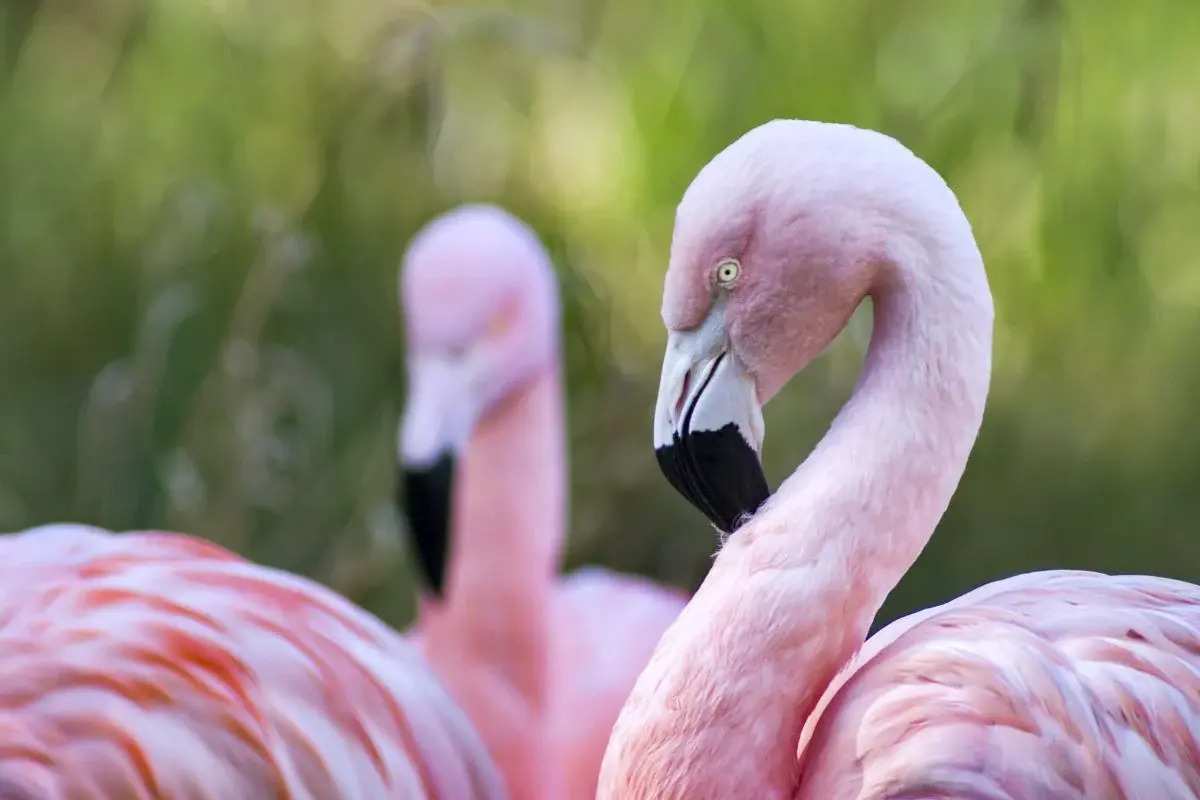
Ever wondered why flamingos are pink or how they can stand on one leg for so long without getting a cramp? Well, you're in for a treat! Flamingos are among nature's most fascinating birds, with their vibrant colors and unique behaviors captivating bird watchers and animal lovers alike. From their quirky eating habits to their impressive migratory patterns, these birds hold secrets that are just waiting to be uncovered. Whether you're a seasoned ornithologist or just someone who appreciates the beauty of the natural world, these 20 flamingo facts will surely amaze you. So, let's dive into the world of flamingos and discover what makes these feathered creatures so incredibly special.
Key Takeaways:
- Flamingos get their pink color from their diet, and they live in large groups for protection and better mating opportunities. They are also excellent flyers, reaching speeds up to 37 miles per hour during migration.
- Conservation efforts are crucial for flamingos, as they face threats from habitat loss, pollution, and illegal hunting. With ongoing conservation and awareness, we can ensure a bright future for these magnificent birds.
What Makes Flamingos Pink?
Ever wondered why flamingos sport their iconic pink feathers? It's not just for style. Flamingos are born with grey feathers. Their vibrant color comes from their diet, rich in beta-carotene. This substance is found in algae and crustaceans, which flamingos feast on. Over time, beta-carotene accumulates in their feathers, turning them pink.
- Flamingos' pink color is due to their diet, specifically the beta-carotene in algae and crustaceans.
The Social Life of Flamingos
Flamingos are quite the social birds, preferring to live in large groups. These gatherings can sometimes consist of thousands, creating a stunning visual spectacle. Living in such large groups helps protect them from predators and increases their chances of finding a mate.
- Large groups, sometimes consisting of thousands, are typical for flamingos, offering protection and better mating opportunities.
How Flamingos Eat
Have you ever seen a flamingo eat? It's quite a unique sight. Flamingos feed by stirring up mud with their feet, then they bend their necks upside down and use their specially adapted beaks to filter out food from the water. This feeding style is as efficient as it is peculiar.
- Flamingos feed by stirring mud and filtering food from the water with their upside-down beaks.
The Mystery of the One-Legged Pose
One of the most iconic poses in the animal kingdom is a flamingo standing on one leg. But why do they do this? Scientists believe this behavior helps conserve body heat, as tucking one leg closer to their body reduces heat loss in cold water.
- Standing on one leg helps flamingos conserve body heat by reducing heat loss.
Flamingo Families
Flamingo couples are quite dedicated. They build their nests together, and both parents take turns incubating their single egg. Once the chick hatches, parents feed it a special milk produced in their digestive system, rich in fat and protein.
- Both parents share in incubating the egg and feeding their chick with a special milk they produce.
Migration and Habitat
Flamingos are not just tropical birds; they can be found in various environments, from salt lakes to lagoons in different parts of the world. Some species migrate over vast distances to exploit seasonal food sources and breeding sites.
- Flamingos inhabit diverse environments and some species migrate long distances for food and breeding.
The Flamingo's Lifespan
Flamingos are among the longest-living birds, with lifespans that can reach up to 50 years in the wild. In captivity, with the absence of predators and regular veterinary care, they can live even longer.
- Lifespans of flamingos can reach up to 50 years in the wild, and longer in captivity.
The Language of Flamingos
Flamingos are quite vocal. They use a range of sounds to communicate within their large groups, from honking to growling. These sounds play a crucial role in their social interactions, including mating rituals and establishing territories.
- Flamingos use a variety of sounds for communication, including honking and growling.
The Speed of Flamingos
Despite their awkward appearance on land, flamingos are strong fliers. They can reach speeds up to 37 miles per hour, with their long legs and necks stretched out straight, covering great distances during migration.
- Flamingos can fly at speeds up to 37 miles per hour, covering great distances during migration.
Conservation Status
While some flamingo species are thriving, others face threats from habitat loss, pollution, and illegal hunting. Conservation efforts are crucial to ensure these beautiful birds continue to grace our planet for generations to come.
- Conservation efforts are vital for flamingos, as some species face threats from habitat loss, pollution, and illegal hunting.
Flamingo's Unique Beak Design
Flamingos have one of the most unusual beak designs in the bird world. Their beaks are adapted to filter feed, allowing them to extract food from water while sifting out mud and debris. This specialized beak is a key to their survival in the wild.
- Their beaks are uniquely designed for filter feeding, a key adaptation for their survival.
The Colorful World of Flamingos
Not all flamingos are pink. Depending on their diet and species, flamingos can range in color from pale pink to a bright red or even orange. The intensity of their coloration is directly related to the amount of carotenoid pigments in their diet.
- Flamingos' colors can vary from pale pink to bright red or orange, depending on their diet and species.
The Importance of Mud for Flamingos
Mud plays a crucial role in the life of a flamingo. They use mud to build their nests, which are cone-shaped mounds that protect their eggs from flooding and overheating. These mud nests are a testament to the flamingo's ingenuity.
- Mud is essential for flamingos, used in building cone-shaped mounds to protect their eggs.
The Flamingo's Global Family
Flamingos belong to the bird family Phoenicopteridae and are found on every continent except Antarctica. This wide distribution shows their adaptability to different climates and environments, from the hot African plains to the cooler European wetlands.
- Flamingos are found worldwide, except in Antarctica, showcasing their adaptability to various climates.
The Flamingo's Role in Ecosystems
Flamingos play a significant role in their ecosystems. Their feeding habits help stir up the bottom of water bodies, bringing nutrients to the surface and supporting a healthy aquatic environment. This makes them key players in maintaining the balance of their habitats.
- Their feeding habits help maintain healthy aquatic environments, making them crucial for ecosystem balance.
The Symbolism of Flamingos
Throughout history, flamingos have been symbols of beauty and balance. In ancient Egypt, they were associated with the sun god Ra, representing the sun's vibrant energy and life. Today, they continue to captivate us with their elegance and mystery.
- Flamingos have symbolized beauty and balance, from ancient Egypt to modern times.
The Threat of Climate Change
Climate change poses a significant threat to flamingo populations. Rising temperatures and changing rainfall patterns can disrupt their habitats, affecting their food supply and breeding grounds. Protecting these birds requires global efforts to combat climate change.
- Climate change disrupts flamingo habitats, affecting their food supply and breeding grounds.
The Flamingo's Night Vision
Flamingos have excellent night vision, which allows them to feed in the cooler, less crowded hours of the night. This ability gives them an advantage in avoiding predators and exploiting food sources not available during the day.
- Excellent night vision allows flamingos to feed at night, avoiding predators and exploiting unique food sources.
The Impact of Human Activity
Human activities, including development and pollution, have a profound impact on flamingo habitats. Protecting these environments is essential for the survival of flamingo populations, requiring concerted conservation efforts and sustainable practices.
- Human activities impact flamingo habitats, necessitating conservation efforts for their survival.
The Future of Flamingos
With ongoing conservation efforts and increased awareness, the future for flamingos can be bright. By protecting their habitats and addressing threats like climate change and pollution, we can ensure these magnificent birds continue to thrive.
- Ongoing conservation efforts and awareness are key to ensuring a bright future for flamingos.
A Final Flurry of Flamingo Fascination
We've journeyed through a world where flamingos paint the sky pink and dance on one leg, uncovering secrets from their vibrant colors to their unique behaviors. These birds aren't just a pretty sight; they're marvels of nature, adapting to some of the harshest environments on Earth. From their intricate social lives to their impressive migratory patterns, flamingos continue to captivate and intrigue us. Whether it's their ability to drink boiling water or the fact that their knees actually bend the other way, every fact about these birds adds another layer to our admiration. So next time you spot a flamingo, either in the wild or at a zoo, remember there's more to these creatures than meets the eye. They're not just part of nature's backdrop but key players in the ecosystem, embodying resilience, beauty, and the sheer unpredictability of the natural world.
Frequently Asked Questions
Was this page helpful?
Our commitment to delivering trustworthy and engaging content is at the heart of what we do. Each fact on our site is contributed by real users like you, bringing a wealth of diverse insights and information. To ensure the highest standards of accuracy and reliability, our dedicated editors meticulously review each submission. This process guarantees that the facts we share are not only fascinating but also credible. Trust in our commitment to quality and authenticity as you explore and learn with us.


